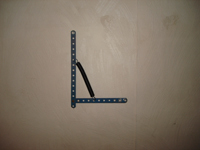| Learning Aims: | ||
 The pupils are to learn that the skeletal muscles work in pairs with one that contracts and one that relaxes or lengthens. Muscles are fastened to the skeleton on different sides of the joint. Their strength depends on the size of the muscle and the distance between the joint and the point at which the muscle is attached. The pupils are to learn that the skeletal muscles work in pairs with one that contracts and one that relaxes or lengthens. Muscles are fastened to the skeleton on different sides of the joint. Their strength depends on the size of the muscle and the distance between the joint and the point at which the muscle is attached. |
||
| Subejct: | ||
| Biology, physics | ||
| Materials: | ||
| Diagrams of a muscle, Meccano (or similar) and a dynamometer or steel spring. | ||
| Suggestions for use: | ||
|
During the course of this activity, it is highly likely that questions about building up muscles will arise. In that case, it is appropriate to discuss types of training for strength - if one wants to build large, strong muscles or to build up more endurance. To achieve large, strong muscles, one must load the muscles to engage more muscle cells in the exercise. To build big muscles, all the cells in the muscle must become larger. If the goal is to build up more endurance, the muscles must loaded more moderately, but over many exercises. While one is still growing, the best thing is simply to work with one’s own body as the load. Ask the pupils to discuss each of the pictures in terms of strength and function. Which muscle is the strongest? What are the advantages and disadvantages of each of these possible examples? Muscles work according to the principle of leverage. In figure A, the muscle doesn’t work at all, as it is connected to the same bone at both ends. There is no leverage. In principle, Figure C shows the strongest muscle, as the distance between the point of connection and the joint is the greatest. On the other hand, with arm muscles like this, one would be so clumsily built it would be difficult to move with ease. In order to demonstrate the physics explanations, one can work with Meccano either in metal or in wood. Ask the pupils to construct a model of an arm with the muscles attached according to the picture on the left. Use a dynamometer and compare which of the three examples A – C gives the strongest muscle: that which performs the most work.
|

